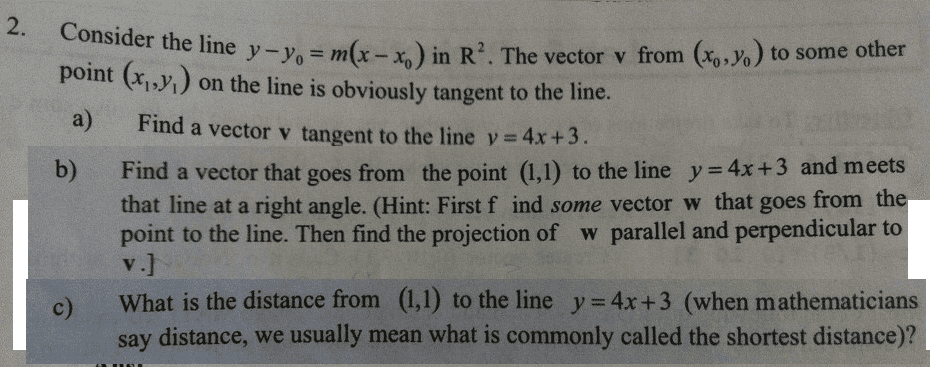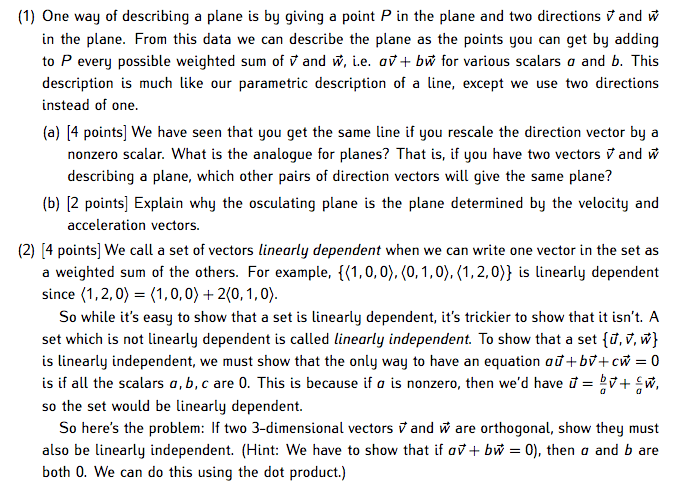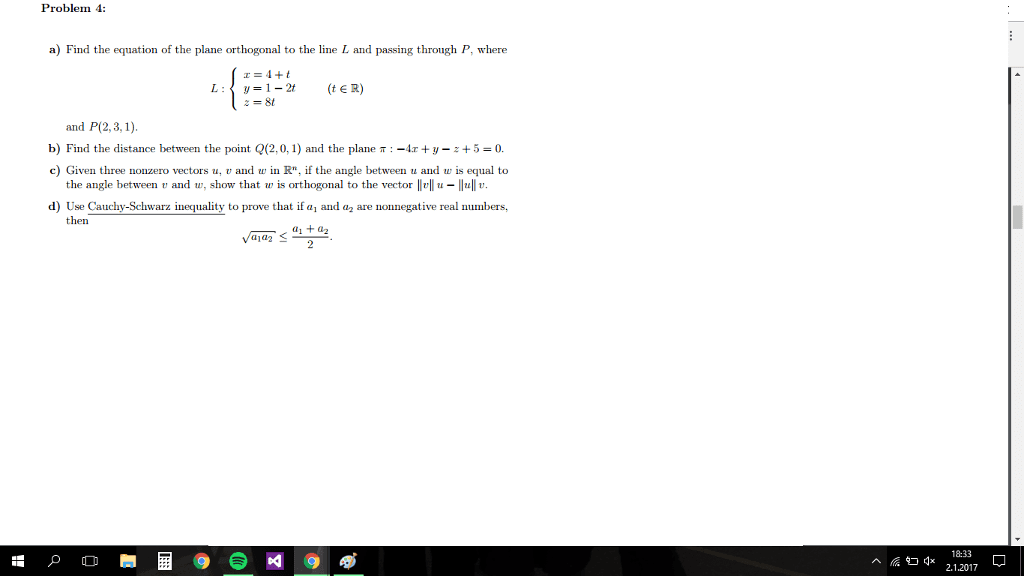MATH136 Lecture Notes - Lecture 8: Hypotenuse, Cartesian Coordinate System, Dot Product

Wednesday, May 17
−
Lecture 8 : Projections onto lines and planes in ℝ3 (Refers to
section 1.5)
Concepts:
1. projection of a vector b onto a vector a (or onto a line L) in ℝ2 and ℝ3.
2. representation of the vector w = perpab.
3. computing projab.
4. shortest distance between a point b and a line L in ℝ3.
5. point on a line L which is closest to a point .
6. projection of a vector onto a plane.
7. Point on a plane which is closest to a point.
8. finding the distance between a point b and a plane P(n, a) in ℝ3.
8.1 Projections − Occasionally, one might want to express a vector x as a sum of two
orthogonal vectors (perpendicular vectors), called orthogonal component vectors of x.
Suppose we are given a vector b in ℝ2 and another vector a. Suppose we want to express
b as the sum of a scalar multiple of a, say ta, and another vector w, such that ta ⊥ w. In
this lecture we study how this can be done.
8.2 Definition − Let b be a vector in ℝ2 or ℝ3 and let a be any other vector in the same
space. We define the projection of b onto a as being the vector p = proja(b) = ta, where t
is such the vector b − p is orthogonal to p. Intuitively, the point, proja(b), is the point on
the line L = {ta : t ∈ ℝ} which is the closest to b. The expression b − proja(b) = b – p is
denoted by perpab. (This expression is pronounced “perpab onto a”).
A few remarks:
- The vector p = proja(b) is a scalar multiple of the directed line segment a.
- If in ℝ2, we have defined p = proja(b) so that the points (0, 0), p, and b form a right
triangle. (The directed line segment of b forming the hypotenuse).
- So it is always true that
b = proja(b) + perpa(b)
Remark.
The fact that proja(b) is the point on the line ta which is the closest to the point b is
something that must normally be proven. (Optional: See the end of these lecture for a
proof of this.)

In the following example the points a and b are such that we are only required to plot
the points in the Cartesian plane to see what the point projba is.
8.2.1 Example − Consider the vector b = (−4, 3) and let a = (2, 0). Compute proja(b).
Solution:
It is easy, in this case, to graphically visualize, and then identify what proja(b) is.
Then p = proja b = −2(2, 0) = (−4, 0) and perpa b = b – p = (−4, 3) − (−4, 0) = (0, 3).
8.3 How to compute projab. We will show that the (orthogonal) projection of b onto a
is given by the expression
We will assume neither a nor b is the zero-vector. Suppose p = ta and the scalar t is such
that perpa b = b − p is orthogonal to p = ta. Then b − p is orthogonal to a. That is,
a ⋅ (b − ta) = 0. Applying dot product properties
Then
Hence
8.3.1 Definition
−
If L is the line x = td possing through 0 our understanding of what
the projection of a vector onto another vector is allows to define, reasonably, the
projection of the vector b on the line L as projLb = projdb. So projLb is the point on
the line L = {td : t ∈ ℝ} which is the closest to b.
Note: The fact that the formula for projLb does indeed produce the point on L which
is the closest to b must be proven. The proof will not be presented here.
8.3.2 Example
−
Find the projection, projvu, of u = (2, 3, 1) onto v = (1, 2,
−
6) .
Also find the norm of the projection.

Solution:
- We want proj(1, 2, -6)(2, 3, 1). Note that || v ||2 = 41 and u ⋅ v = 2. Hence
- The norm of the projection is
8.3.3 Note – See that, by definition, perpvu is always orthogonal to projvu.
The question “Find the point on the line x = t(1, 2,
−
6) = tv which is the closest to the
point u = (2, 3, 1)” is equivalent to the question asked in the above example.
Note – In the above example, the “shortest distance” which separates the point
u = (2, 3, 1) from the line x = t(1, 2,
−
6) = tv is given by the expression
|| u – projvu|| = || perpvu ||
8.3.4 Example – If b is the point (2, 2, 2) and L is the line t(1, 0, 1) find the point on L
which is closest to b. Also find the shortest distance which separates b from L.
Solution :
- The point on L closest to b is the projection of b onto the direction vector
d = (1, 0, 1) of L.
- Verify that projd b = (2, 0, 2)
- The shortest distance is || b – projdb || = || (2, 2, 2) – (2, 0, 2) || = 2.
8.4 is optional material. The shortest distance from a point b to a line a + td in ℝ3.
8.4 Projection of a vector b onto a line L = {x : x = a + td}.

34
MATH136 Full Course Notes
Verified Note
34 documents
Document Summary
Suppose we are given a vector b in 2 and another vector a. 8. 2 definition let b be a vector in 2 or 3 and let a be any other vector in the same the line l = {ta : t } which is the closest to b. The expression b proja(b) = b p is. 8. 1 projections occasionally, one might want to express a vector x as a sum of two orthogonal vectors (perpendicular vectors), called orthogonal component vectors of x. space. We define the projection of b onto a as being the vector p = proja(b) = ta, where t is such the vector b p is orthogonal to p. intuitively, the point, proja(b), is the point on. The vector p = proja(b) is a scalar multiple of the directed line segment a. A few remarks: denoted by perpab. (this expression is pronounced perpab onto a ). triangle. (the directed line segment of b forming the hypotenuse).






